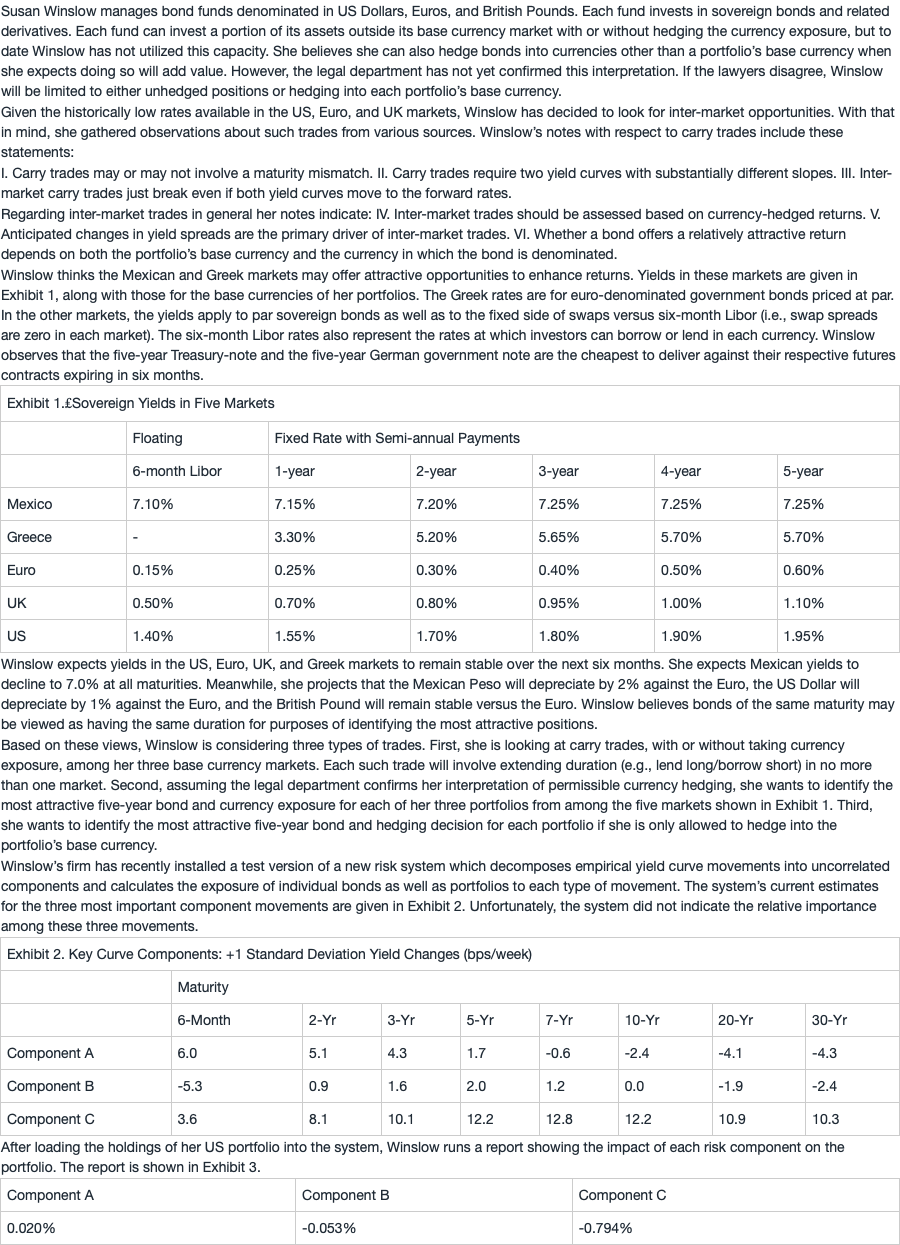NO.PZ201902210100000103
问题如下:
Susan Winslow manages bond funds denominated in US Dollars, Euros, and British Pounds. Each fund invests in sovereign bonds and related derivatives. Each fund can invest a portion of its assets outside its base currency market with or without hedging the currency exposure, but to date Winslow has not utilized this capacity. She believes she can also hedge bonds into currencies other than a portfolio’s base currency when she expects doing so will add value. However, the legal department has not yet confirmed this interpretation. If the lawyers disagree, Winslow will be limited to either unhedged positions or hedging into each portfolio’s base currency.
Given the historically low rates available in the US, Euro, and UK markets, Winslow has decided to look for inter-market opportunities. With that in mind, she gathered observations about such trades from various sources. Winslow’s notes with respect to carry trades include these statements:
I. Carry trades may or may not involve a maturity mismatch. II. Carry trades require two yield curves with substantially different slopes. III. Inter-market carry trades just break even if both yield curves move to the forward rates.
Regarding inter-market trades in general her notes indicate: IV. Inter-market trades should be assessed based on currency-hedged returns. V. Anticipated changes in yield spreads are the primary driver of inter-market trades. VI. Whether a bond offers a relatively attractive return depends on both the portfolio’s base currency and the currency in which the bond is denominated.
Winslow thinks the Mexican and Greek markets may offer attractive opportunities to enhance returns. Yields in these markets are given in Exhibit 1, along with those for the base currencies of her portfolios. The Greek rates are for euro-denominated government bonds priced at par. In the other markets, the yields apply to par sovereign bonds as well as to the fixed side of swaps versus six-month Libor (i.e., swap spreads are zero in each market). The six-month Libor rates also represent the rates at which investors can borrow or lend in each currency. Winslow observes that the five-year Treasury-note and the five-year German government note are the cheapest to deliver against their respective futures contracts expiring in six months.

Winslow expects yields in the US, Euro, UK, and Greek markets to remain stable over the next six months. She expects Mexican yields to decline to 7.0% at all maturities. Meanwhile, she projects that the Mexican Peso will depreciate by 2% against the Euro, the US Dollar will depreciate by 1% against the Euro, and the British Pound will remain stable versus the Euro. Winslow believes bonds of the same maturity may be viewed as having the same duration for purposes of identifying the most attractive positions.
Based on these views, Winslow is considering three types of trades. First, she is looking at carry trades, with or without taking currency exposure, among her three base currency markets. Each such trade will involve extending duration (e.g., lend long/borrow short) in no more than one market. Second, assuming the legal department confirms her interpretation of permissible currency hedging, she wants to identify the most attractive five-year bond and currency exposure for each of her three portfolios from among the five markets shown in Exhibit 1. Third, she wants to identify the most attractive five-year bond and hedging decision for each portfolio if she is only allowed to hedge into the portfolio’s base currency.
Winslow’s firm has recently installed a test version of a new risk system which decomposes empirical yield curve movements into uncorrelated components and calculates the exposure of individual bonds as well as portfolios to each type of movement. The system’s current estimates for the three most important component movements are given in Exhibit 2. Unfortunately, the system did not indicate the relative importance among these three movements.

After loading the holdings of her US portfolio into the system, Winslow runs a report showing the impact of each risk component on the portfolio. The report is shown in Exhibit 3.

Among the carry trades available in the US, Euro, and UK markets, the highest expected return for the USD-denominated portfolio over the next 6 months is closest to:
选项:
A.0.275%.
B.0.85%.
C.0.90%.
解释:
B is correct.
The highest potential return, 0.85%, reflects borrowing USD for 6 months and buying the UK 5-year bond. The carry component of the expected return is actually a loss of 0.15% [= (1.10% – 1.40%)/2], but this is more than offset by the 1% expected appreciation of GBP versus USD. A much higher carry component +0.90% = (1.95% – 0.15%)/2 could be obtained by borrowing for 6 months in EUR to buy the US 5-year note, but that advantage would be more than offset by the expected 1% loss from depreciation of the USD (long) against the Euro (short).
A is incorrect because a higher expected return of 0.85% can be obtained. This answer, +0.275% [= (1.95% – 1.40%)/2], is the highest carry available over the next 6 months within the US market itself (an intra-market carry trade).
C is incorrect. This answer (+0.90%) is the highest potential carry component of return but ignores the impact of currency exposure (being long the depreciating USD and short the appreciating Euro).
您好
这里算Rdc的收益率时为什么不用derivatives里面 Rdc=(1+Rfc)(1+Rfx)这个公式,而直接是 Rdc=Rfc+Rfx?是不是在fixed income中都用这种简化方法?
谢谢




